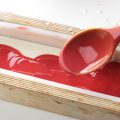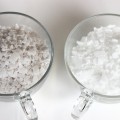I’ve been soaping for a blissful fourteen years now. I love it. I crave it. There is very little that makes me happier than seeing a perfect trace in my soap or the smooth texture of a freshly cut batch of soap (big sigh). If I could only make soap all day and never have to actually work for money (you know, answer emails, rally staff, figure out new products, and all the assorted minutiae that comes with running a business), I would be exceedingly happy.
Still, there is a minor downside to soapmaking – safety considerations. To make soap from oil requires a bit of complex chemistry. The short story is that you need lye or sodium hydroxide. Lye is mostly commonly found in things like Draino to clean drains. It is also used to react with fats (like olive oil or coconut oil) to make soap. It is highly, highly caustic and will actually burn you So, when I make soap, I wear long sleeves and long pants and goggles (and look, there’s the photo off to the left to prove it). I usually skip the gloves because I’m pretty used to lye burns at this point in my soaping career.
I don’t like lye burns but as long as I wash them off my hands quickly, I’m none the worse for the wear. And since I’ve been making soap for so long, I (humble modesty coming up right here) am pretty good at it and tend not to spill too much fresh burning soap on my hands. So, no gloves.
I made the most delicious batch of Fresh Baked Bread soap today. It smells amazing, it acted like a dream and soapmaking was a snap. I was set up, weighed, measured, traced and poured in about 20 minutes. Then clean up time. Cleaning up fresh soap is a bit of a pain. This is because it is essentially thick, sludgy oil. It takes a bit of patience, a good degreasing soap and boiling hot water. While I was cleaning up, I managed to pour some fresh soap right into a cut on my hand.
Yowzers! Talk about sharp, intense pain! Note to self and soapers out there: if you have a cut on your hand, definitely wear gloves. Holy soaping gods, it still hurts a few hours later! And my cut is all pink and puffy. It is very impressive in its obvious nature. The take away lesson for me is the obvious one stated above (gloves, you fool, gloves) and also that even with fourteen plus years of soaping under my belt, I am not above making mistakes and learning what every newbie soaper knows: lye burns can hurt.





I just clean lye products up with running water and soap. Lye typically goes down the drain since it’s the main component of drain cleaner so it can go down your drain with lots of water =)
I’ve been reading up on soap making for the last three years and am about ready to jump in. Nothing I’ve read though covers how to clean up any lye residue (from either some that has spilt, or from what may be left after pouring the lye out of my designated glass lye container…or any other equipment the lye may touch for that matter). Do you have any suggestions? I’m assuming it would be caustic and a hazard to use soap and water to clean the lye up. How do I clean my equipment and utensils,etc that have been in contact with the lye?
Otion, the retail store, sells those beautiful aprons. On the particular apron I’m wearing in the photo, I had it embroidered. It was a $75 set up fee and then a minimal fee for embroidery. I would have more made except that the person that did the embroidery up and left town! Sigh. With my $75 set up fee …
Anne-Marie
I was browsing through your blog today and noticed this picture in the”On Lye And Lye Burns”. Do you sell those beautiful aprons?
They are very nice, AM!